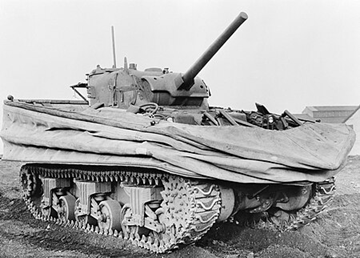THE DUPLEX DRIVE TANKS OF
D-DAY
Unfortunately
our speaker from the Aylsham Roman Project due to speak
to us could not make it.
It was to our advantage that Stuart Burgess who
works for Norfolk Museum Services stepped in at the last
minute. Stuart
is a Landscape Archaeologist and has carried out a
detailed study of Fritton Lake’s WW2 heritage. Fritton Lake,
owned by the Somerleyton Estate was requisitioned in
1943 for the elementary phase of training and
development of the Duplex Drive amphibious
swimming tanks fondly referred to as Donald Duck tanks. In 1942
disaster unfolded on the beaches of Dieppe whilst
unloading tanks, both infantry and craft became easy
targets.
The 79th
Armoured Division was established and were charged with
the development of the Swimming Tank. Valentine
tanks were used in the prototype, Duplex drive refers to
the fitted propellers allowing propulsion through the
water which supplemented the usual track. Providing
enough buoyancy with the tanks weighing 30 tonnes was a
difficult engineering problem but there was not enough
time to develop new vehicles. The DD tanks
were considered to be vital in providing close fire
support to infantry on D-Day.
The
problem was solved by a floatation screen made of
waterproof canvas fitted to the tank’s hull just above
the running gear. A
series of tubular frames were mounted horizontally
giving the shape to the screen which was held taut by
metal struts and vertical tubes filled with compressed
air. When collapsed it enabled the tank to enter into
combat role. It
became clear that although permission was given by the
Ministry of Supply for the manufacture of 450 Valentine
DD’s, it became clear that the Sherman was more suitable
for use with the screen, one reason was that the Sherman
could move in water with its gun forward ready to fire
as soon as land was reached also the Valentine was older
and generally of inferior design.
247
Valentine DD and 693 Sherman DD were built in the United
Kingdom during 1943-4.
On the
calm waters of Fritton Lake crews learnt to waterproof
and maintain their tanks, including learning how to use
Amphibious Tank Escape Apparatus. Security was
key and being surrounded by woodland Fritton Lake was
and still is one of the most important historical places
of WW2. Following
their Freshwater training the crews moved to saltwater
training this took place at Stokes Bay Gosport. Having loaded
onto landing craft the tanks would be launched into the
Solent, 1200 yards off the Isle of Wight at Osborne. By
March 1944, 1200 men had participated in the training.
The
intention on D-Day was for the DD tanks to arrive on the
beaches minutes before the infantry to provide armoured
support. Despite
poor weather over half were launched into the Channel. A third were
lost at sea due to the bilge pumps not being able to
cope with water coming over the screens, those that did
swim to shore provided significant support to the
Infantry.
In this
year as we celebrate the end of WW2, we were, and are
reminded of the brave and courageous young men and women
who gave themselves for the freedom that we enjoy today.

Above:
DD Sherman Tank
with its
Flotation screen
lowered.
 Return to home
page
Return to home
page